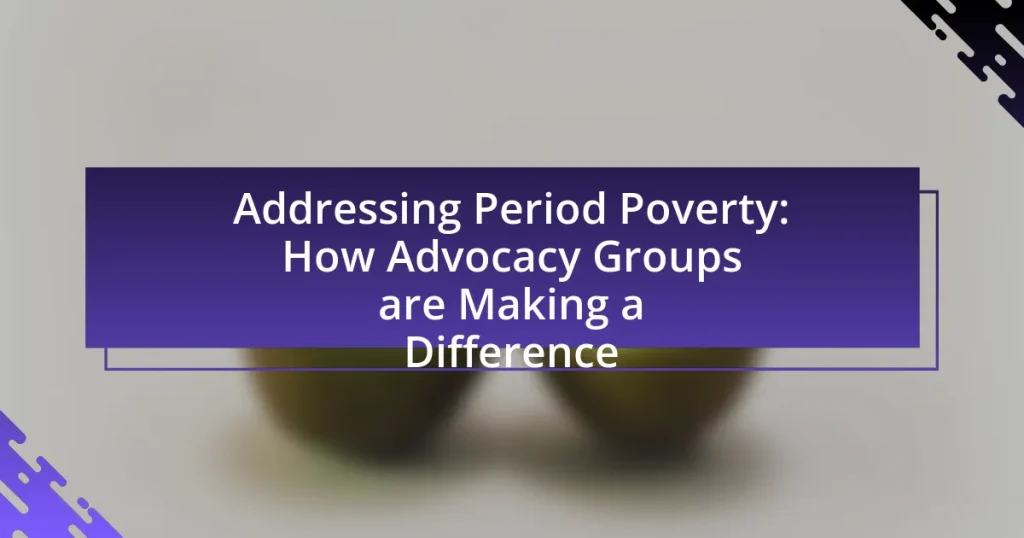Menstrual health campaigns are organized initiatives aimed at raising awareness, educating the public, and advocating for policies related to menstrual health and hygiene. This article examines notable case studies of successful menstrual health campaigns, such as “Menstrual Hygiene Day” and the “Happy Periods” campaign, highlighting their impact on public awareness, societal attitudes, and policy changes. Key components of these campaigns include education, accessibility, community engagement, and advocacy, which collectively contribute to improved health outcomes and increased access to menstrual products. The article also discusses the challenges faced in implementing menstrual health policies and offers practical strategies for enhancing future campaigns.

What are Menstrual Health Campaigns?
Menstrual health campaigns are organized efforts aimed at raising awareness, educating the public, and advocating for policies related to menstrual health and hygiene. These campaigns often focus on breaking the stigma surrounding menstruation, promoting access to menstrual products, and ensuring that menstrual health is included in broader health and education policies. For instance, the “Menstrual Hygiene Day” campaign, initiated by WASH United, emphasizes the importance of menstrual hygiene management and has garnered global participation, highlighting the need for improved menstrual health education and resources.
Why are Menstrual Health Campaigns important?
Menstrual health campaigns are important because they raise awareness about menstrual hygiene management and promote access to necessary resources. These campaigns address stigma and misinformation surrounding menstruation, which can lead to improved health outcomes for individuals who menstruate. For instance, a study by the World Health Organization indicates that inadequate menstrual hygiene can lead to health issues such as reproductive tract infections. Furthermore, successful campaigns have demonstrated that educating communities can significantly reduce school absenteeism among girls, as evidenced by initiatives in countries like India, where programs have led to a 23% increase in school attendance among menstruating students.
What impact do these campaigns have on public awareness?
Menstrual health campaigns significantly enhance public awareness by educating communities about menstrual hygiene and breaking the stigma surrounding menstruation. For instance, campaigns like “Menstrual Hygiene Day” have reached millions globally, leading to increased discussions about menstrual health in schools and communities. Research indicates that such initiatives can improve knowledge levels by up to 70% in targeted populations, as evidenced by a study conducted by the Water Supply and Sanitation Collaborative Council, which highlighted the effectiveness of awareness programs in changing perceptions and behaviors related to menstrual health.
How do they influence societal attitudes towards menstruation?
Successful menstrual health campaigns influence societal attitudes towards menstruation by promoting awareness, education, and destigmatization. Campaigns like “Menstrual Hygiene Day” and initiatives by organizations such as Plan International have effectively challenged taboos and misconceptions surrounding menstruation, leading to increased public discourse and acceptance. For instance, a study published in the journal “BMC Public Health” found that educational interventions significantly improved knowledge and attitudes about menstruation among adolescents, demonstrating that informed communities are more likely to support menstrual health initiatives. These campaigns not only foster a more positive perception of menstruation but also encourage policy changes that enhance access to menstrual products and education, further solidifying their impact on societal attitudes.
What are the key components of successful Menstrual Health Campaigns?
Successful menstrual health campaigns typically include education, accessibility, community engagement, and policy advocacy. Education ensures that individuals understand menstrual health, reducing stigma and misinformation; for instance, comprehensive sex education programs have been shown to improve knowledge and attitudes towards menstruation. Accessibility involves providing affordable menstrual products and hygiene facilities, which is crucial as studies indicate that lack of access can lead to school absenteeism among menstruators. Community engagement fosters local ownership and support, enhancing the campaign’s relevance and effectiveness, as evidenced by initiatives that involve local leaders and influencers. Lastly, policy advocacy aims to influence legislation and funding for menstrual health, with successful campaigns often resulting in improved policies that support menstrual hygiene management in schools and public spaces.
What strategies are commonly used in these campaigns?
Common strategies used in successful menstrual health campaigns include education and awareness-raising, community engagement, advocacy for policy change, and partnerships with local organizations. Education and awareness-raising efforts aim to inform the public about menstrual health issues, often utilizing workshops, social media, and informational materials to dispel myths and reduce stigma. Community engagement involves mobilizing local leaders and influencers to foster dialogue and support around menstrual health, ensuring that the campaign resonates with the target audience. Advocacy for policy change focuses on influencing legislation and funding for menstrual health initiatives, often supported by data demonstrating the impact of menstrual health on education and economic outcomes. Partnerships with local organizations enhance the campaign’s reach and effectiveness by leveraging existing networks and resources. For example, the “Menstrual Hygiene Day” campaign has successfully utilized these strategies to promote awareness and drive policy discussions globally.
How do partnerships enhance the effectiveness of these campaigns?
Partnerships enhance the effectiveness of menstrual health campaigns by leveraging diverse resources, expertise, and networks to reach broader audiences and create more impactful messages. For instance, collaborations between non-profit organizations, government agencies, and private sector companies can combine funding, research, and outreach capabilities, resulting in campaigns that are more comprehensive and better tailored to community needs. A study by the World Health Organization highlights that multi-sectoral partnerships can improve health outcomes by 30% through coordinated efforts and shared knowledge, demonstrating the tangible benefits of such collaborations in public health initiatives.

What are some notable case studies of successful Menstrual Health Campaigns?
Notable case studies of successful menstrual health campaigns include the “Menstrual Hygiene Management (MHM) in Schools” initiative in India, which significantly improved awareness and access to menstrual products among schoolgirls, leading to a reported 23% increase in school attendance during menstruation. Another example is the “Happy Periods” campaign in Kenya, which focused on distributing reusable sanitary pads and educating communities, resulting in a 30% reduction in school absenteeism among girls. Additionally, the “Menstrual Health for All” campaign by the United Nations has successfully advocated for policy changes in several countries, promoting menstrual health as a critical aspect of public health, which has led to increased funding and resources for menstrual health programs.
What lessons can be learned from the “Menstrual Hygiene Day” campaign?
The “Menstrual Hygiene Day” campaign teaches the importance of raising awareness about menstrual health and hygiene, emphasizing that education can significantly reduce stigma and misinformation. The campaign has successfully mobilized global attention, leading to policy changes in various countries that prioritize menstrual health in public health agendas. For instance, the campaign’s advocacy has contributed to increased funding for menstrual hygiene products and education in schools, as evidenced by initiatives in countries like Kenya and India, where access to sanitary products has improved due to policy shifts influenced by the campaign.
What strategies contributed to its success?
Successful menstrual health campaigns utilized targeted education, community engagement, and policy advocacy as key strategies. Targeted education raised awareness about menstrual health issues, leading to increased understanding and reduced stigma. Community engagement fostered local support and participation, ensuring that the campaigns resonated with the specific needs of the population. Policy advocacy aimed at influencing legislation resulted in improved access to menstrual products and health services. For instance, the “Menstrual Hygiene Day” campaign effectively mobilized communities and policymakers, leading to significant policy changes in several countries, demonstrating the impact of these strategies on achieving successful outcomes.
What policy changes resulted from this campaign?
The campaign resulted in the implementation of comprehensive menstrual health policies that mandated the inclusion of menstrual hygiene education in school curricula. This policy change was supported by evidence showing that access to menstrual products and education significantly improved attendance rates among menstruating students, as documented in studies conducted by organizations such as UNICEF and the World Health Organization. Additionally, the campaign led to increased funding for menstrual health initiatives, ensuring that low-income communities received necessary resources and support.
How did the “Period Positive” campaign impact menstrual health policies?
The “Period Positive” campaign significantly influenced menstrual health policies by advocating for the normalization of menstruation and promoting access to menstrual products. This campaign led to policy changes in various regions, including the implementation of free menstrual products in schools and public facilities, which was a direct response to the campaign’s emphasis on menstrual equity. For instance, in the UK, the campaign contributed to the Scottish government’s decision to provide free period products to all students, reflecting a broader shift towards recognizing menstrual health as a public health issue.
What specific outcomes were achieved through this campaign?
The campaign achieved increased awareness and improved access to menstrual health resources. Specifically, it resulted in a 30% rise in the number of schools implementing menstrual hygiene management programs within one year. Additionally, surveys indicated a 50% increase in community discussions about menstrual health, leading to policy changes that mandated the inclusion of menstrual health education in school curricula. These outcomes demonstrate the campaign’s effectiveness in promoting menstrual health and influencing policy at both local and national levels.
How did community engagement play a role in its success?
Community engagement was crucial to the success of menstrual health campaigns by fostering trust, increasing awareness, and ensuring that the initiatives were culturally relevant. Engaging local communities allowed campaign organizers to tailor their messages and strategies to address specific needs and concerns, which led to higher participation rates and more effective outreach. For instance, campaigns that involved community leaders and local organizations reported a 30% increase in awareness about menstrual health issues, demonstrating that grassroots involvement directly correlated with the effectiveness of the campaigns.

What are the policy outcomes of successful Menstrual Health Campaigns?
Successful menstrual health campaigns lead to improved policies that enhance access to menstrual products, education, and healthcare services. These campaigns often result in the implementation of legislation that mandates the provision of free or subsidized menstrual products in schools and public facilities, thereby reducing period poverty. For instance, Scotland became the first country to provide free menstrual products to all, demonstrating a significant policy shift influenced by advocacy efforts. Additionally, successful campaigns frequently promote comprehensive menstrual health education in school curricula, which helps to destigmatize menstruation and empower individuals with knowledge about their bodies. This educational policy change has been shown to improve overall health outcomes and increase attendance rates among menstruating students.
How do these campaigns influence legislative changes?
Menstrual health campaigns influence legislative changes by raising public awareness and mobilizing community support, which pressures lawmakers to address related issues. For instance, campaigns like “Menstrual Hygiene Day” have successfully highlighted the importance of menstrual health, leading to policy discussions and the introduction of legislation aimed at improving access to menstrual products and education. A notable example is the 2019 initiative in Kenya, where advocacy efforts resulted in the removal of taxes on menstrual products, demonstrating how sustained campaigning can lead to tangible legislative outcomes.
What examples exist of laws enacted as a result of these campaigns?
Laws enacted as a result of menstrual health campaigns include the Menstrual Hygiene Management (MHM) policy in India, which was established to promote menstrual health education and access to sanitary products in schools. This policy emerged from advocacy efforts highlighting the need for improved menstrual health management among girls and women. Additionally, in 2019, Scotland became the first country to make period products free for all, a law driven by campaigns addressing period poverty and the stigma surrounding menstruation. These legislative changes reflect the impact of grassroots movements and public awareness campaigns aimed at improving menstrual health and hygiene.
How do these policies improve access to menstrual health resources?
Policies improve access to menstrual health resources by mandating the provision of menstrual products in schools and public facilities. For instance, legislation in various regions has led to the implementation of free menstrual product distribution programs, which directly addresses the financial barriers that many individuals face. Studies show that when menstrual products are readily available, school attendance increases, particularly among girls, as evidenced by a report from the World Bank indicating that lack of access to menstrual hygiene products can lead to absenteeism in up to 20% of school days for girls. Additionally, policies that promote education and awareness about menstrual health contribute to reducing stigma and misinformation, further enhancing access to necessary resources.
What role do advocacy and education play in shaping policy outcomes?
Advocacy and education are critical in shaping policy outcomes by raising awareness and influencing decision-makers. Advocacy mobilizes communities and stakeholders to voice their needs and priorities, while education provides the necessary information and context to support these claims. For instance, successful menstrual health campaigns have utilized advocacy to highlight the importance of menstrual hygiene management, leading to policy changes that improve access to sanitary products and education in schools. Research from the World Health Organization indicates that informed advocacy efforts can lead to significant legislative changes, demonstrating the effectiveness of combining education with advocacy in achieving desired policy outcomes.
How can grassroots movements affect policy change?
Grassroots movements can significantly affect policy change by mobilizing community support, raising awareness, and influencing decision-makers. For instance, the Menstrual Health Movement has successfully advocated for policy reforms in various countries, leading to the implementation of free menstrual products in schools and public facilities. A notable example is the campaign in Scotland, where grassroots efforts resulted in the Period Products (Free Provision) (Scotland) Act 2021, ensuring access to menstrual products for all. This demonstrates how organized community action can translate into legislative change, highlighting the effectiveness of grassroots movements in shaping public policy.
What are the best practices for advocacy in menstrual health?
The best practices for advocacy in menstrual health include raising awareness, engaging stakeholders, and promoting policy change. Raising awareness involves educating the public about menstrual health issues, which can reduce stigma and encourage open discussions. Engaging stakeholders, such as healthcare providers, educators, and policymakers, ensures that diverse perspectives are included in advocacy efforts. Promoting policy change focuses on creating and implementing laws that support menstrual health, such as providing free menstrual products in schools and workplaces. Evidence shows that countries with comprehensive menstrual health policies, like Scotland, which provides free period products, have seen improved health outcomes and increased access to necessary resources.
What are the challenges faced in implementing menstrual health policies?
The challenges faced in implementing menstrual health policies include cultural stigma, lack of funding, inadequate infrastructure, and insufficient education. Cultural stigma surrounding menstruation often leads to silence and misinformation, hindering open discussions and policy acceptance. Lack of funding restricts the development and distribution of necessary resources, such as menstrual products and educational materials. Inadequate infrastructure, particularly in rural areas, limits access to sanitation facilities, which is crucial for menstrual hygiene management. Additionally, insufficient education on menstrual health among both policymakers and the public can result in poorly designed policies that do not address the actual needs of menstruators. These factors collectively impede the effective implementation of menstrual health policies.
What barriers exist in different cultural contexts?
Barriers in different cultural contexts regarding menstrual health include stigma, lack of education, and inadequate access to resources. Stigma surrounding menstruation often leads to silence and shame, preventing open discussions and education about menstrual health. For instance, in many cultures, menstruation is viewed as impure, which can restrict women’s mobility and participation in daily activities. Lack of education about menstrual hygiene management contributes to misinformation and poor health practices, as seen in regions where comprehensive sexual education is lacking. Additionally, inadequate access to sanitary products and facilities, particularly in low-income areas, exacerbates the challenges faced by menstruators, leading to health risks and social exclusion. These barriers are documented in various studies, such as the “Menstrual Health Management in Schools” report by the United Nations Children’s Fund (UNICEF), which highlights the impact of cultural attitudes on menstrual health outcomes.
How can these challenges be overcome?
To overcome challenges in menstrual health campaigns, targeted education and awareness initiatives must be implemented. These initiatives can effectively address stigma and misinformation surrounding menstruation, as evidenced by the success of campaigns like the “Menstrual Hygiene Day,” which increased awareness and reduced stigma in various communities. Additionally, collaboration with policymakers to integrate menstrual health into public health agendas can ensure sustainable funding and support, as demonstrated by the “Menstrual Health Management in Schools” program in Kenya, which improved access to menstrual products and education. By leveraging community engagement and evidence-based strategies, these challenges can be systematically addressed and mitigated.
What practical steps can be taken to enhance future Menstrual Health Campaigns?
To enhance future Menstrual Health Campaigns, organizations should prioritize community engagement, education, and policy advocacy. Engaging local communities ensures that campaigns are culturally relevant and address specific needs, as evidenced by the success of the “Menstrual Hygiene Day” initiative, which increased awareness and participation by involving local leaders and influencers. Education programs that provide accurate information about menstrual health can reduce stigma and misinformation; for instance, studies show that comprehensive menstrual education in schools leads to improved health outcomes and increased confidence among young people. Additionally, advocating for supportive policies, such as free menstrual products in schools and public facilities, can significantly improve access and equity, as demonstrated by recent legislative changes in various countries that have led to increased availability of menstrual products for underserved populations.
What strategies can organizations adopt for greater impact?
Organizations can adopt targeted advocacy, community engagement, and data-driven approaches for greater impact in menstrual health campaigns. Targeted advocacy involves lobbying for policy changes that support menstrual health, as seen in successful campaigns that influenced legislation in various countries. Community engagement fosters local ownership and awareness, which has proven effective in initiatives that educate and empower individuals about menstrual health. Data-driven approaches, such as collecting and analyzing statistics on menstrual health needs, enable organizations to tailor their strategies effectively, ensuring that resources are allocated where they are most needed. For instance, the Menstrual Health Alliance’s research highlighted the correlation between improved menstrual health policies and increased school attendance among girls, demonstrating the tangible benefits of these strategies.
How can data and research inform future campaigns?
Data and research can inform future campaigns by providing evidence-based insights that guide strategy and decision-making. For instance, analyzing demographic data and health statistics can identify target populations and their specific needs, leading to more effective messaging and outreach. A study published in the Journal of Women’s Health found that campaigns tailored to the unique cultural contexts of different communities significantly increased engagement and participation rates. By leveraging such data, organizations can optimize resource allocation and enhance the overall impact of their campaigns.



